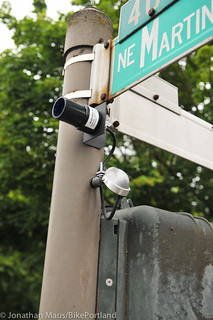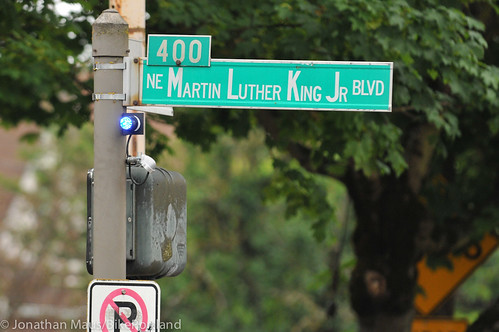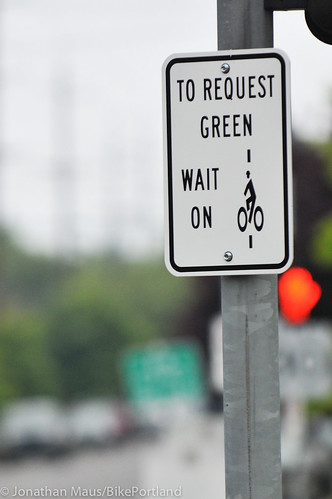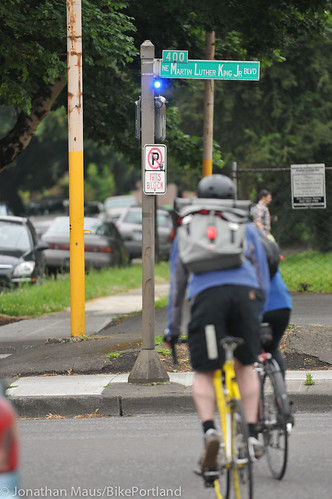One unsung area where Portland is doing some very cool stuff for bicycling is with traffic signals and “ITS” — which stands for Intelligent Transportation Systems. The field of ITS encompasses all sorts of high-tech ways to make our streets smarter. From sensing vehicle patterns with RFID, to software that manages complex signal systems.
Around Portland, some of the most innovative examples of traffic engineering fall under this category. ITS is how PBOT managed to improve bike access on the NE 12th overcrossing without upsetting nearby freight-dependent businesses. It’s also how they dealt with the notorious right hooks on Broadway at Williams (with bike-only signals).
PBOT is quietly becoming a leader in this field. Did you notice the recent press release from Bikes Belong about their Green Lane Project? The head of that project said, Portland’s, “attention to detail to bicycle operations at intersections and other transition points is unmatched.”
This morning I spent some time investigating PBOT’s latest experiment in making our streets more intelligent: a traffic signal loop detector indicator light specifically for people on bikes.
On NE MLK Jr. Blvd at Morris, there’s a small, blue LED light facing traffic headed westbound on Morris.
Morris is a designated route for bicycle traffic to cross MLK (a high-volume arterial and state highway). Like many intersections in Portland, PBOT has installed “loop detectors” in the pavement that tell the signal a vehicle is present. These loops are triggered by bicycles and they tell the signal a bike rider is present; but the problem is, not everyone uses them. In order to encourage folks to use these detectors, PBOT has stenciled bike symbols in the location where you should wait, and they’ve also begun adding signage that reads, “To request green, wait on [symbol]”.
Here’s a photo of the pavement marking and the sign (these are at numerous intersections throughout the city)…
Those measures help; but there’s still no way for people to be confident they’ve triggered the light (and many people on bikes still roll over and push the crosswalk button). That’s where the new blue signal comes in. At Morris and MLK, a bright blue light immediately comes on when the loop detector is activated.
I asked PBOT’s Division Manager of Signals, Street Lighting, and ITS, Peter Koonce, to explain more about it:
“The problem that we’re trying to solve is this: there are times when a person on their bicycle reaches a traffic signal and aren’t sure if they are detected by the sensors. This is particularly problematic with new riders that haven’t learned to look for the stencil that we mark on the pavement or for experienced ones where we haven’t maintained the [stencil] marking.”
Koonce says the indicator light is necessary because it “provides information to the user” and that information, he says, is a good way to prevent users from violating the red light. The thinking is, if the person knows their presence has been triggered, they’re more likely to wait for the green — especially in situations where a small side street intersects a major arterial where auto and transit traffic is prioritized.
“We’re going to see if this helps with compliance,” says Koonce, “and get feedback on whether these should be standard practice.”
These type of indicators are commonly used in the Netherlands, and Koonce saw them first-hand on a recent trip.
From my observations, the new indicator light at Morris and MLK works well. It’s very sensitive and it came on for all the bikes I watched roll up (it also works for cars too of course). To test the sensitivity, I stood on the stencil without my bike. It didn’t come on. Then I grabbed my bike and it lit up immediately.
If you expect the light to turn green for you right away, you might be disappointed. The sensor might know you’re there, but NE Morris is not as important in the eyes of the system as NE MLK. PBOT says they have to sync the signal with others on MLK, and they put more weight on auto and transit traffic on MLK than a few bikes on Morris.
Even so, this type of innovation is key to building a network that respects bicycle traffic to the same degree it respects auto traffic.
Have you noticed this new light? What do you think?
— For more background read, Bike Science: Making sense out of traffic signal sensors.







